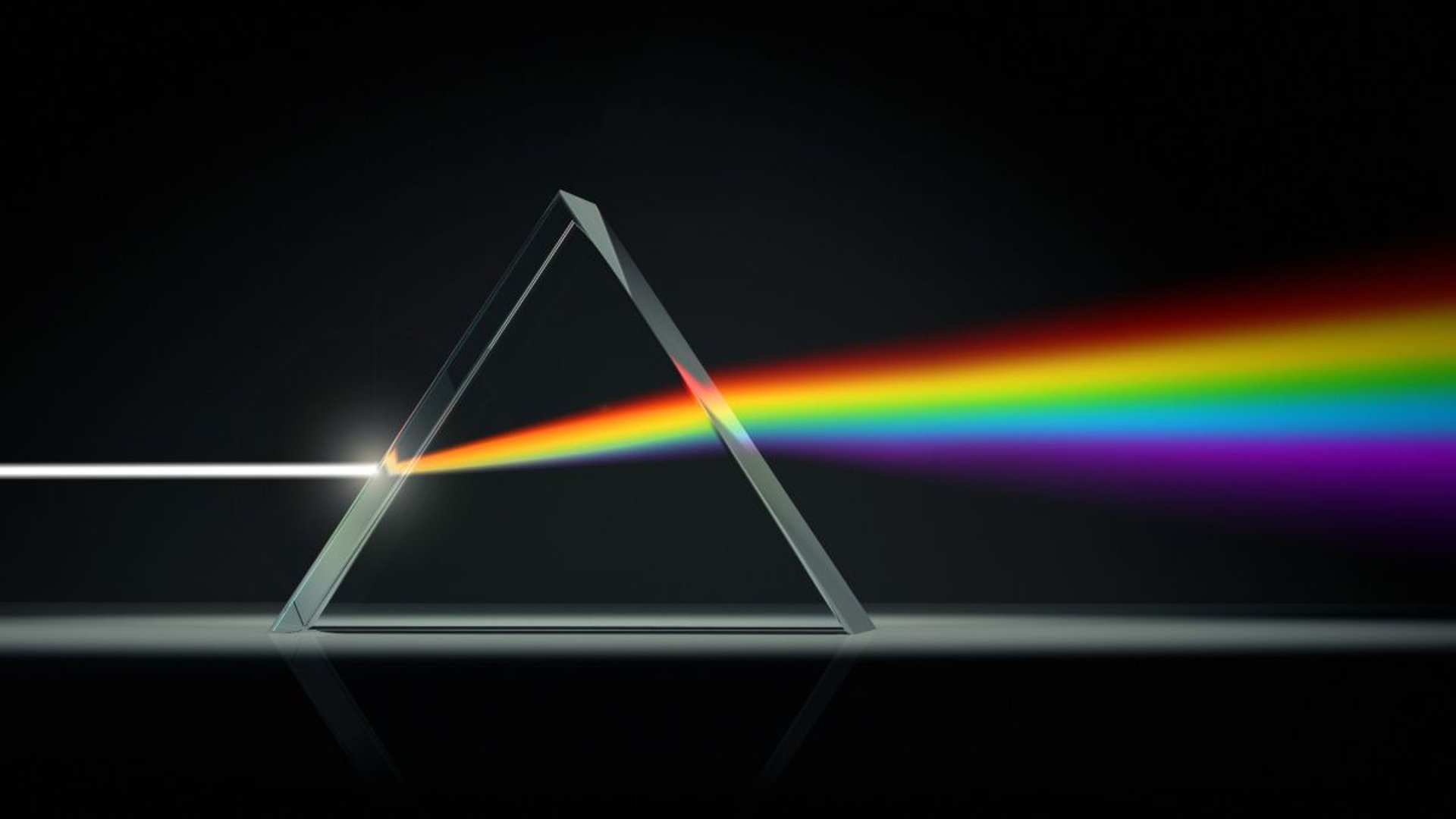
Children of the Rainbow: Part I
Constructing the Chromatic Zodiac
The Birth of the Science of Color
Nearing the last few months of his life Isaac Newton made a confession, of sorts, to his nephew, John Conduitt, who was compiling biographical information on his famous uncle. Newton confided in him that it was in the summer of 1663, two years into his undergraduate work at Trinity College, Cambridge, that he purchased a book on astrology at the midsummer fair at Stourbridge. He implied that it was this book that sparked his life-long pursuit into the physical sciences. This book was most likely a divinatory treatise written by Dr. Richard Saunders in that same year (one of only four works on astrology found in Newton’s library at the time of his death). After attempting to decipher the mystifying images and astrological charts, Newton was compelled to comprehend them by furthering his extra-curricular investigations of geometry and higher mathematics; he took up reading Euclid, René Descartes, Frans van Schooten, and others, in order to have a better working knowledge of astrology.
Apparently, Newton’s conclusion at the time, was that the state of judicial astrology was one of “vanity and emptiness”. Indeed, the practice of predictive astrology was in a heyday just a few decades earlier yet had fallen into intellectual disfavor by the middle of the 17th century; where, relegated to the pseudo-scientific background, it has waxed and waned ever since. Not so ironically, Newton was primarily occupied with the studies of alchemy and theology; subjects which when interpreted ‘correctly’, reveal allegories of metaphysical and celestial principles that are ripe for extrapolating patterns in physical reality. Both areas of study are concerned with the elementary and evolutionary processes of nature and spirit, and they express the transmutations of states of matter and states of consciousness. Interestingly, he was fascinated with the search for the occult Philosopher’s Stone and hidden meaning within the religious texts pertaining to the Temple of Solomon, as well as with sacred geometry associated with Kabbalah. A cursory look at numerous texts written in his own hand, reveal that he had a working knowledge of the planetary correspondences with the materials of alchemy, and their qualities and behaviors.
In this article series, I will discuss new insights pertaining to one of Newton’s favorite subjects – light. I will lay out a series of findings which suggest a mathematical link between color-frequency, specifically chromaticity, and distinct patterns within the trigonometry of the Zodiac. We will also introduce quantifiable variables of color science, which imply a natural relationship to the Fibonacci Sequence and discuss how these patterns are also rooted in astrology. This unexplored facet of the electromagnetic spectrum appears to be only now revealing its secrets, not through conventional scientific channels, but through a deeper exploration of metaphysics. Don’t worry about the science or mathematics in this article, I will keep it simple. This is an expansive and complex topic, which may further our understanding of the numerical simplicity of nature and help to reforge the kinship between the scientific and astrological communities.
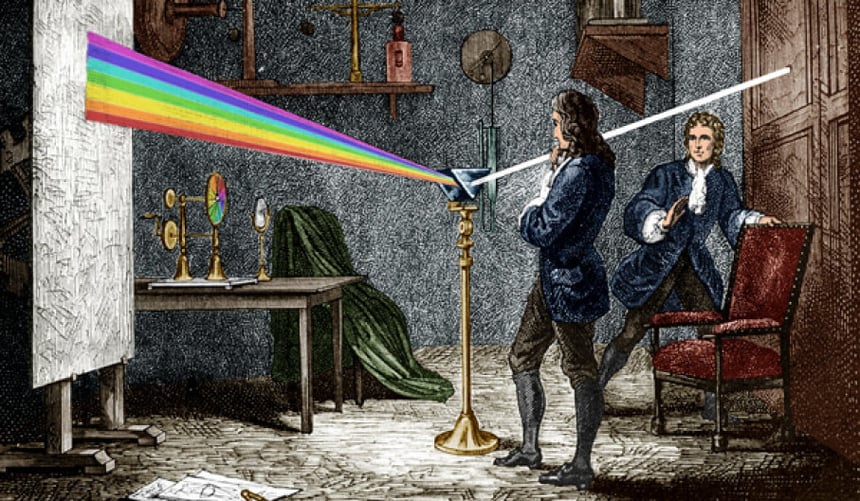

Let There Be Light….
As astrologers, we know that fundamentally astrology is the study of light. Whether you view it as a spiritual practice, a science or something in between, the purpose is to better understand the forces of dark and light – without and within. Each chart is a representative ‘snapshot’ of various patterns of interacting gravitational and electromagnetic forces, describing a network of connections between points of matter and the qualities of their interacting energies. We may not think of it that way on a regular basis, but a natal chart communicates empirical scientific data which we interpret in a psychological or spiritual context. We study and detail narratives of patterns of behavior within society and the self, which have emerged in the past and how they will emerge in the future. We analyze the frequency, direction, and angles of light emitted from the Sun, that same light as it is reflected from the planets, as well as how that light as it interacts with gravitational nodes and the light emitted from other stars and asterism. We track events which correspond to forces, energies, and geometries as they repeat in time. Whether one likes the title or not, ultimately, we are all spiritual scientists.
The Color of Astrology
Early on in my own study of astrology, one of the more confusing issues for me was the wide range of color schemes used for the elements, the signs, and the planets. After going over astrological color arrangements from many schools of thought and various world traditions, rarely did two ever match. Yet, there are certain concepts within the various schemes which seem to align almost universally. Take the element Fire, the sign of Aries, the planet Mars, and the color red, for example; in nearly every culture throughout history these metaphysical and astrological components tend to agree with each other. From a physics perspective, red light consists of the longest wavelengths, and it is the first (cardinal) visible color arising from the invisible infrared portion of the electromagnetic spectrum. In astrology and alchemy, this cardinal characteristic or initiating behavior of red light is described in metaphysical terminology and allegorical language. Yet these characteristics are qualitatively the same as represented by objective scientific reasoning. So why is there little agreement with colors within astrology?
Gurus, yogis, and sages write elaborate treatises on astrological colors. Some connect the colors of precious stones to the light qualities of the various planets, or they associate certain colors to rulers of the days, weeks, months, and subsequently the signs. Other teachers and authors employ a mix of color palettes to each of the signs, or they use combinations of elemental or base colors in a myriad of methodologies. And given a level of logic behind each of the color systems, none of them can be faulted in their own right. They each bare a truth in their respective schools of thought. But since there is obviously little consistency between astrological color systems, how do we begin to bring the frequencies of color into harmony with both astrological and scientific principles? Is there a correspondence between astrology and the physics of electromagnetism, quantum physics, biophysics, astrophysics, and the fundamental forces…? And what can we agree upon that indicates a link between the natural sciences and astrology?
From Darkness into Light: An Evolving Science
In 1666, Uranus was in Aquarius and Pluto was ending its passage through Gemini, Newton began his fascination with light. It was because of his scientific experiments on light and color during this time that he is often referred to as the father of the modern ‘science of optics’ as one of his many epithets. In 1672, with Pluto at 5˚ of Cancer, his first works on color were published in the newly created scientific journal of the Royal Society. Filed under a New Theory of Light and Colors, his work firmly established one side of the scientific debate on the particle nature of light, sparking a feud with other leading scientists of his day. It was this problematic question that would remain unresolved for the better part of two more centuries, which would lead to the acceptance of particle-wave duality and birth the new field of quantum physics at the dawn of the 20th century.
In 1913, Uranus was in Aquarius, as Pluto was again ending its passage through Gemini, the CIE (International Commission on Illumination) was founded in Europe. The CIE is the international authority on light, illumination, color, and color spaces. In 1918, Pluto was back again at 5˚of Cancer, Optica - the Journal for The Optical Society, was first published (an exact Pluto cycle from the Royal Society publication of Newton’s first work on optics). This period birthed a new level of international cooperation between industry and science in the field of photonics. It also became crucial to the quickly expanding quantum sciences. In 1931, the CIE produced the RGB and the XYZ color spaces (see diagram), defining the first quantitative links between wavelength distribution in the electromagnetic spectrum and the human perception of color. The following decades would see subtle adjustments to these color models but for the most part they remain the core of the mathematical tools for color management and understanding chromatic relationships.
The Spectral Model of the Zodiac
R-G-B vs R-Y-B
Let’s address an obvious issue right up front. What’s the correct color model to use, and why? Many models exist but of the two basic astrological color schemes which have emerged in the last century, I observed with relative consistency that the Fire Sign (Aries, Leo and Sagittarius) used either the primary colors of R-Y-B (red-yellow-blue) -or- R-G-B (red-green-blue). For many years I was in the camp of an RYB zodiacal color arrangement for reasons that I could not reconcile, either mathematically or by using a basic geometric color wheel. Red made sense for Aries, yellow made sense for Leo, and by relative reasoning medium blue made sense for Sagittarius. There is a common misconception that the three “primary colors” are red, yellow, and blue because that is what we are usually taught in elementary school art class, but those are the primary colors of pigments that are used to create colors on materials. The primary colors of light are red, green, and blue, and that is what we are dealing with. This simple distinction is important to a mathematically relevant color space and how it relates to quantifiable patterns within the light spectrum and the patterns found in the Zodiac. We will proceed with the understanding that we are working with the additive process of light rather than the subtractive processes of physical materials.
The Visible Spectrum
As a reminder, the electromagnetic spectrum extends from the very-low frequency radio and infrared waves (reds) to the ultra-high frequency gamma and cosmic rays (blues). The visible spectrum, everything we can see, is a just a tiny sliver in the middle of this extensive range of frequencies and energies all around us. To put this in perspective, if you were to take an old 35mm celluloid movie film and stretch it from Los Angeles, California to Miami, Florida, the visible spectrum would occupy just one frame near the center of the strip (around my home of Austin, Texas). The wavelengths in this range are measured in nanometers (nm). The longer waves of color arise on the red end of the spectrum are in the mid-700nm range, while the shorter blue-violet waves descend just below the 400nm range. This visual range is only approximate, yet it does provide a good starting point towards mapping a chromatic-based Zodiac model. For simplification purposes, at this time using 380nm as the edge of black-violet to 740nm for to red-black boundary as the visible spectral colors.
The spark of ‘color’ is a very small attribute of electromagnetic radiation. No radiation can be entirely “monochromatic” (derived from a single light source), since that would require it to have the same intensity and frequency for all time, with no beginning or end – the Zeroth dimension. A physical reality must have variable frequencies. This is a mathematical consequence of the Fourier transform’s localization property, which we have discussed in previous discourses as a complex-value function expressed as the time domain of the Zodiac. Nothing, including time, could exist in a pure monochromatic reality; radiation always consists of multiple component frequencies. (**Interestingly, as I write this paragraph, I am watching a scene from the latest Marvel superhero film Thor: Love & Thunder, in which the villain extracts the energy from color in the surroundings, drawing resources from the shadows. The scenes become increasingly desaturated, fading into darkness as he succeeds, until bravery, hope, compassion, and finally love return to the heroes, restoring color and energy to reality. An achromatic world would be bleak and lifeless indeed.) Color is a crucial and fundamental component of this dimension.
Color Space: HSL and HSV
How do we integrate color as a quantifiable metric of the natural structure of the Zodiac? First, let’s define our color space. We require a symmetric RGB color model. The model should be adaptable for either two- or three-dimensional axes and correspond to fundamental shapes (circles, squares) and solids (spheres, cubes). For symmetry and ease of use, I am using the 2D radial diagram, a circle, as the primary color model. The HSL (hue, saturation, lightness) and HSV/HSB (hue, saturation value/brightness) color models are probably familiar to you as a color ‘palette’ in the standard color picker wheel in many software applications. For a number of technical arguments, which I will not delve into here, we will be using the HSV color space, which represents the RGB color model. The HSV color space is a defined cylindrical (circular) geometry, starting with pure red at 0˚, pure green at 120˚, pure blue at 240˚ and ending back at 360/0˚ red. Both the additive primary RGB and the secondary CMY (cyan, magenta, yellow) colors are represented in a geometric arrangement around the outside edge of the cylinder with a saturation value of 1. Each of the RGB tristimulus values are measured in the decimal code from 0-255. Here in Diagram 3, in the first row I have overlayed the Zodiac on top of the visible spectrum linearly using the degrees of circle. In the second row, each of the RGB primary color variables, are shown every 60˚.
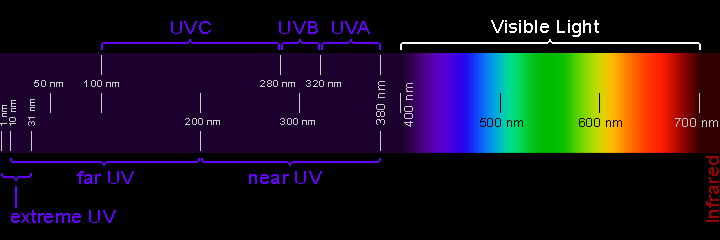

Chromaticity
The science of color is still evolving, and its terminology is sometimes confusing. Certain words may mean different things in differing fields, or they may not convey the same components or qualities that the terms are attempting to quantify. The quality of colorfulness encompasses parameters sometimes referenced as saturation, intensity and chroma, as well as other terms for measuring variables. By defining and calculating the photonic metrics within the light, we can apply those values to corresponding components and symmetries found in astrology. As I stated earlier, the CIE chromaticity diagrams are methods of reconciling the visible light spectrum with quantifiable metrics used in thetrichromatic perception of color, i.e., human vision. Using a graph coordinate system, these diagrams also relay parallel information regarding other qualities of color such a temperature, depth, direction, and relative position. Chromaticity is an objective specification of the quality of a color, regardless of its luminance (brightness). It primarily consists of two variables most often referred to as hue and saturation. We will deconstruct these aspects of light and show how the reconfigured color spaces reveal the same mathematical principles as the Zodiac.
Simplifying Color… Building a Chromatic Zodiac
Isaac Newton coined the term spectrum/spectral meaning ‘apparitions’ or ‘appearance’, when referring to the range of visible rainbow colors created by dividing light with a prism. You may recall from elementary school the use of the mnemonic “Roy G. Biv” for red, orange, yellow, green, blue, indigo, and violet; this seven-color based system was also created by Newton. In modern color schemas though, the word indigo is no longer used and the term cyan is used to delineate sky-blue from true blue. (Indigo was a controversial term at the time it was introduced. Indigo actually refers to a dye that produces a range of dark blues, which had just been introduced in London when Newton devised his system.) The range of red to violet makes up the monochromatic visible spectral frequencies produced in nature as one-color frequency. Yet we can perceive another range of colors; the purples, pinks, magentas and crimsons. All of these colors are produced by combining two component wavelengths.
Violet is a single wavelength color, whereas the purples are polychromatic-colors and comprised of more than one spectral frequency. In truth, all colors are comprised of multiple component frequencies but the purples are extra-spectral color combinations of blue, violet, and red. This is known as the ‘line of purples’ in color science. They do not exist as single-wavelength colors, but they do make up part of the Zodiacal configuration. The spectral colors comprise 270˚ of the Zodiac, from the zero -point Aries to the zero-point of Capricorn. I suggest that the remaining 90˚, from 0˚ Capricorn to last degree Pisces is comprised of a complex of spectral frequencies arising within an extra-spatial dimension, with magenta (the Aquarian color) as its fixed point. My personal insight on the matter is that the 90 degrees of the line of purples can be viewed as the higher order of the opposing 90 degrees of the ‘field of greens’, from approximately 494nm to 570nm. Theses parameters give us points to begin establishing the spectrum as a zodiacal model.
**Note: If you are reading this article on a computer screen, you may question how certain colors appear. Remember that each brand of electronic device uses variations of the color gamut and different brightness settings to establish the range of colors. In the next article, we will introduce the hex decimal color code to accurately fix these points.
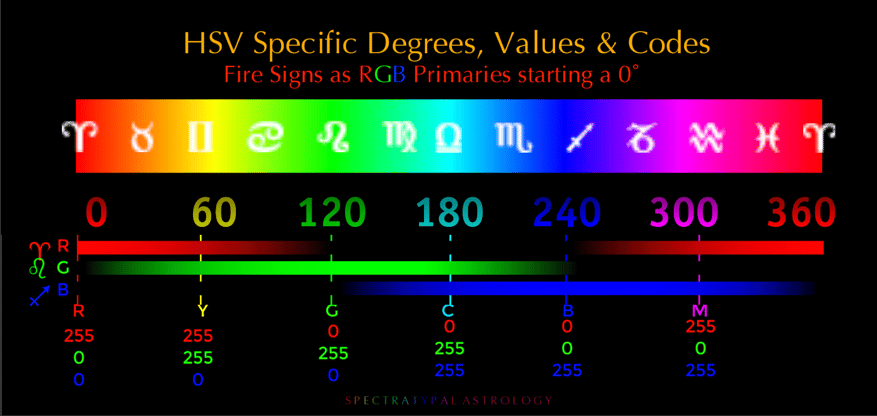

Separating the Light from Darkness: Decomposing Frequency
If everything we perceive consists of vibratory fields of energy and interference patterns, then simple natural processes would be at the foundation of its organizing principles. We can apply the mathematics and the mechanics of self-organizing systems to astrology. Light, the spectrum, is the simplest of these self-organizing systems. By more closely analyzing the Zodiac and the foundations of astrology it is becoming clear that our ancient forefathers had a profound insight of how fundamental the Golden Ratio is and importance to the living forces. Using basic insights into the Fourier transform and the equations of reaction–diffusion systems (i.e., Turing patterns), a natural blueprint is emerging which describes the resonant frequencies, characteristics and behaviors of the signs and planets. In part two of this article (next edition), we will deconstruct the symmetires and relative sequences of both the visible spectrum and the Zodiac to better understand the recpricoal relationship between the two. I hold the view that astrology is rooted in science; and I hope to re-establish firm groundwork for exploring astrology through that perspective… or at least interject a kernal of doubt into the minds of those ardently opposed to it.
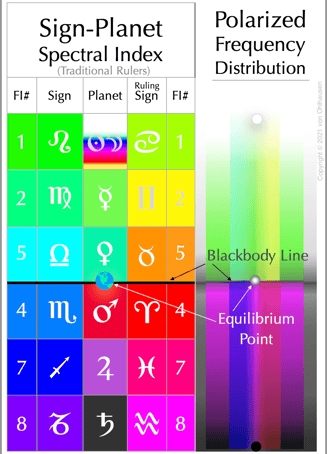

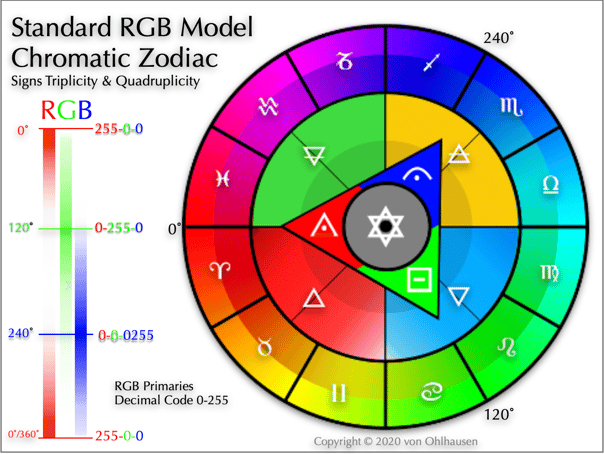

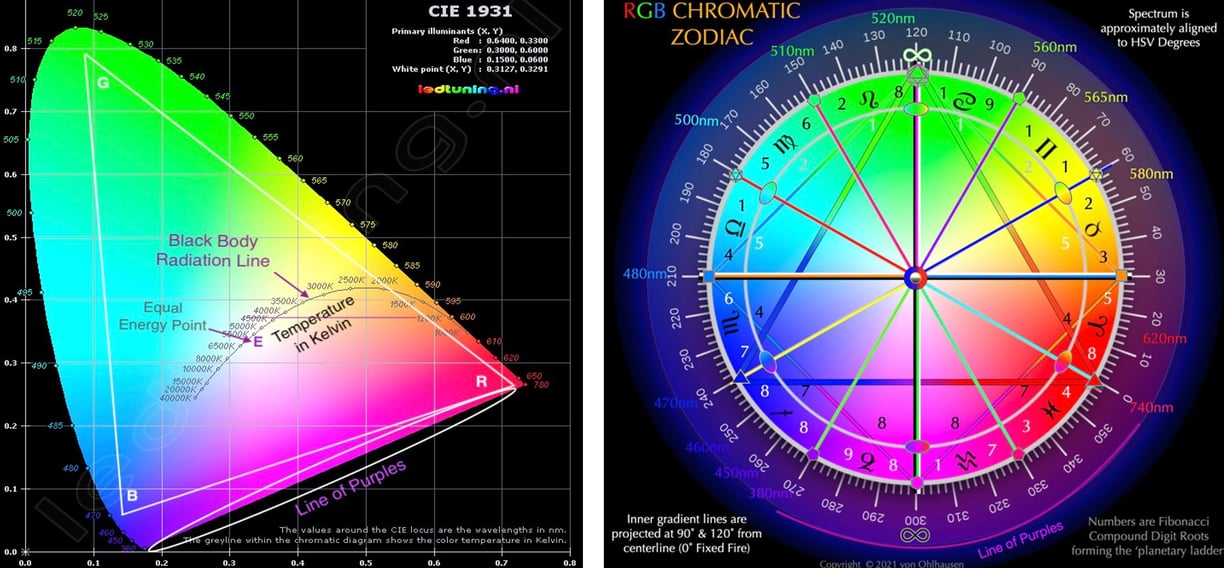

CHILDREN OF THE RAINBOW: PART I
CONSTRUCTING THE CHROMATIC ZODIAC
The Chromatic Zodiac & Planetary Index
I had been working with the idea of an RYB astrological model for several years but essentially every model was arbitrary and “unproveable”. But in 2019 I decided to tackle the question as to why so many Eastern and Western occult and hermetic systems use green for the sign of Leo or for the heart chakra (which aligns with Leo). And this is what I was seeing in the math already, so this is what has led us here. The model that I’ve most recently developed, which has revealed extensive mathematical secrets, came in a flash on November 19th, 2021, while attempting to reconcile the inclusion of both spectral and non-spectral colors in most astrological (and chakral) color systems. When I started applying the RGB color model to the Zodiac, I noticed hidden in the numbers a pattern that I am quite familiar with in nature and astrology – the Fibonacci sequence.
